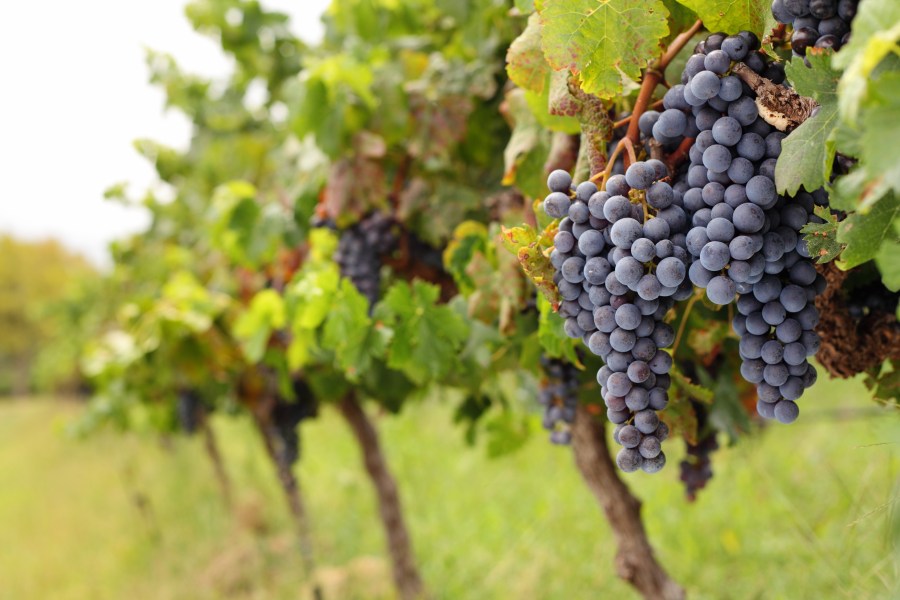Relatively kind spring weather, fortunately without any late frosts, has boosted prospects for this harvest. Hutchinsons agronomists Rob Saunders and Chris Cooper examine how to manage vine canopies to fulfil this promise.
Canopy management at this time of year is all about achieving the optimum leaf-to-fruit ratio. While there are general rules of thumb, such as allowing 10-12 leaves per bunch, determining the ‘correct’ canopy structure is very much down to individual situations, and is a judgement call based on variety, vigour and yield potential.
It can be tempting to try and take as much crop as possible through to harvest, but doing so is often false economy. When vines put all their energy into producing fruit – that may or may not ripen in what is a relatively late season – fewer resources go into laying down good quality buds and canes for next season.
It is worth critically appraising vines to assess what crop load they can realistically carry through to harvest, and monitor growth to ensure there is sufficient vigour to support this, as well as setting foundations for next year. This is especially important in younger, less well established vines.
Where crops, such as some Seyval blanc inspected recently, have produced far more inflorescences than the vine can support, bunch thinning will be required. In most situations, growers can usually wait until fruit is set before deciding how much to thin out, with research suggesting it can be done up until August and still leave time for berries to bulk up. However, where crop load is excessive, earlier action will be necessary.
Tipping not topping
With canopies growing rapidly during early summer, crop load should be balanced against vigour – generally, the more vigorous the vine, the bigger crop it can carry, and vice versa.
Trimming excessive growth and stripping leaves to expose bunches helps optimise light capture, improves airflow, and enhances fruit set by exposing berries to more light. Floral initiation for the following season requires buds to be exposed to sunlight, otherwise there is a risk they will be less fruitful.
Generally, a “little and often” approach is favoured, removing small amounts of extension growth once vines reach the top wire. Two or sometimes three small trims are better than leaving it later and removing a large amount in one go. This often means there are over-thick canopies, which are more difficult to control disease in, and removing larger amounts of material increases the tendency of vines to respond by producing lateral growth.
There are logistical and cost pressures associated with more frequent trimming, but just removing the tips means buds are more likely to remain as potential fruiting buds for next year.
Balancing nutrition
Nitrogen availability is an important driver of canopy growth, but can be tricky to manage, as too much encourages excessive, soft, fleshy growth, and may compromise juice composition, whereas too little can leave vines struggling to lay down sufficient reserves.
On deeper, richer soils, with good moisture availability, there is usually little need for additional nitrogen, whereas on thinner soils in drier areas, it can be worthwhile. Generally, in drier soils, foliar applications are utilised more efficiently by plants than ground-applied nitrogen.
Two other key nutrients at this time of year are calcium and potassium. Calcium increases cell wall rigidity, potentially reducing botrytis risk, and products such as Wuxal Calcium, or CalMax Ultra, which come with additional trace elements, are good options. Potassium supports Brix accumulation and is generally applied once berries are formed.
Nutrient applications should be tailored to crop requirements, and the results of any leaf petiole analysis done at flowering.
Watch for pests
Light brown apple moth has been found in low numbers at vineyards near the south coast, so should be monitored closely. There are two generations each year; one at flowering, which can reduce yield, but the second is often more impactful, as caterpillars feed within bunches, rupturing skins and predisposing bunches to botrytis.
With no published treatment thresholds, deciding when to treat must be on a case-by-case basis. Explicit (indoxacarb), or the biological insecticide Delfin WG, are the main options, as products such as Tracer (spinosad) and Hallmark (lambda-cyhalothrin) are usually reserved for Spotted Wing Drosophila (SWD) control later in the season.
Finally, more vine leaf blister mite damage has been seen this year, favoured by warm, dry, conditions this spring, and last year, which increased carryover. Symptoms can look worse than the damage caused, unless pressure builds to levels that stop vines growing, or affect bunch architecture.
Applying sulphur pre-flowering and post-flowering is normally the main strategy, however in very high-risk situations there may be a need for stronger control in the form of Batavia (spirotetramat).
For more like this, sign up for the FREE Vineyard newsletter here and receive all the latest viticulture news, reviews and insight




